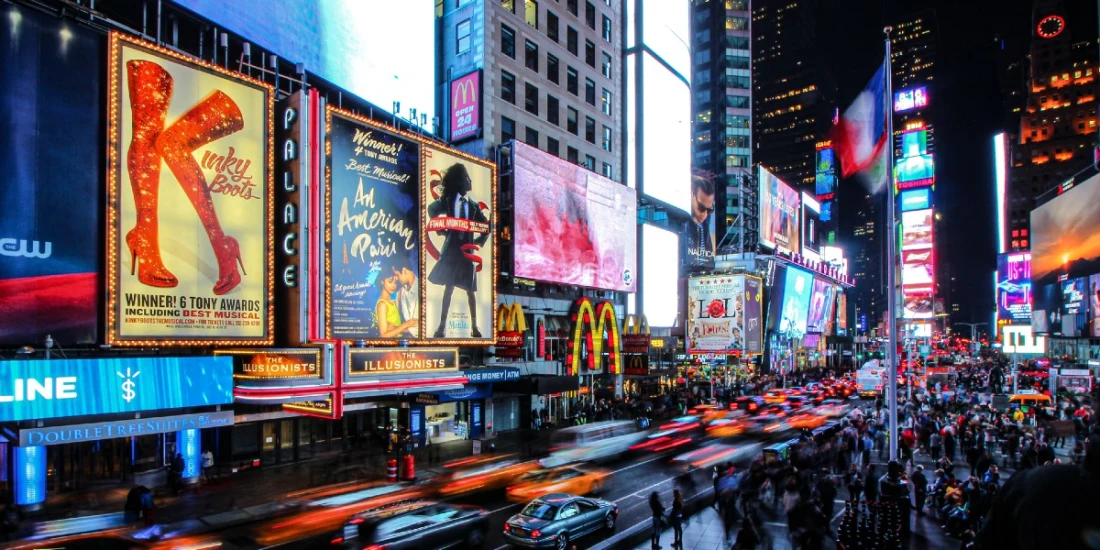A beginner’s guide to Broadway: Shows to see and how to buy tickets
Learn more about Broadway and Broadway shows, the history of Broadway, and how to get Broadway show tickets.
Whether you’re a New York native or you’re heading to the Big Apple for the first time, the neon lights of Broadway are sure to attract anyone. After all, during the 2017-2018 season, 13,792,614 people attended a performance, with over $1 billion of tickets sold.
But, what makes Broadway stand out, and why do people from around the world visit every year? Find out about the world-famous theatre district with our guide, packed with information about why it’s a leading place for theatre.
What is Broadway?
There are 41 official Broadway theatres, and a Broadway theatre does not have to be on the street that lends its name. A Broadway theatre is determined by the specific union contract that governs the employees and regulations of a theatre. While most Broadway theatres are in midtown Manhattan or the surrounding areas, there are also plenty of theatres in the same neighborhood that are not considered Broadway theatres. Only official Broadway shows are eligible for Tony Awards, though, so even though these venues might be neighbors, there needs to be a Broadway contract to earn the Broadway moniker.
From long-running shows like Wicked and Chicago to limited runs and special engagements, there are plenty of shows to enjoy on Broadway.
Where is Broadway?
Broadway is a street that runs for 13 miles through Manhattan and is the oldest main road in New York City, and it is also the longest street. The term “Broadway” derives from the English translation of the Dutch name “Brede Weg,” with brede meaning broad and weg meaning way.
Most Broadway theatres are in midtown Manhattan, but only 4 of 41 theatres are actually located on the street. The rest are located between Sixth and Ninth Avenues (from east to west) and 41st to 54th Streets (from north to south). The one exception is the Vivian Beaumont Theater, located in the Lincoln Center complex on 65th Street and 10th Avenue.
When was Broadway first established?
Before the Revolutionary War, people living in the area that would later become New York state would head to the theatre. In 1750, Thomas Kean and Walter Murray opened a performing arts company that would play to 280 people, putting on Shakespearean plays and operas. Popular shows included The Beggar’s Opera, as well as operas by Gilbert and Sullivan.
At the start of the 20th century, the now-famous bright Broadway marquees were used to promote shows for the first time. White lights brightened the entire area, and it was one of the first places in the United States to be solely lit by electric lights. As a result, Broadway was called “The Great White Way,” a name still used to describe the area today. Early 20th-century shows including Show Boat and Oklahoma! allowed audiences to escape reality and step into a new world, with plays by Arthur Miller and Tennessee Williams also drawing large crowds.
Plays, musicals, and revues continue to attract visitors looking to see the newest shows and classic productions. The longest-running Broadway shows currently running are:
- Chicago: Opened November 14, 1996
- The Lion King: Opened November 13, 1997
- Wicked: Opened October 30, 2003
- The Book of Mormon: Opened March 24, 2011
- Aladdin: Opened March 20, 2014
Other in Broadway history's top 10 include The Phantom of the Opera, the longest-running show of all time with nearly 14,000 performances over 35 years; Life With Father, Broadway's longest-running play ever at 3,224 performances; and Oh! Calcutta!, Broadway's longest-running revue at 5,959 performances.
What shows are there to see on Broadway?
If you’re heading to the Great White Way and stuck on which show to see, why not visit one of Broadway’s newest shows. From Moulin Rouge! The Musical to Six to Hamilton, there’s a show that’s suitable for everyone. To get you started, here's a list of the top Broadway musicals to check out.
Take a look at the newest shows opening this season and get ready to witness unbelievable performances.
Get tickets to shows playing on Broadway.
What is the difference between Broadway and Off-Broadway?
Whether a show is classified as Broadway or off Broadway is not dependent on the location, but on the seating capacity of the theatre and the union contract. A production may be running at a venue on the street of Broadway; however if the seating capacity is small, a show can be, well, off-Broadway on Broadway!
Generally, the ruling is as follows:
- Broadway shows: 500+ seats
- Off-Broadway shows: 100-499 seats
- Off-Off Broadway shows: Fewer than 100 seats
There are exceptions to the rule. For example, Radio City Music Hall is in Midtown and has over 500 seats, but it is not considered a Broadway theatre because it's under a different type of contract.
If a production running at a smaller theatre is successful, it may receive a Broadway transfer from off Broadway, or an Off-Broadway transfer from off-off Broadway.
Should I see an Off-Broadway show?
Yes! There are many established shows that take place away from the bright lights of Broadway. Some long-running, popular Off-Broadway shows include the American transfer of the slapstick comedy The Play That Goes Wrong, the Titanic musical parody Titanique, and the all-ages Gazillion Bubble Show. There’s an Off-Broadway show for everyone.
Discover the top Off-Broadway shows playing right now.
Where can I buy tickets for Broadway shows?
If you’re looking to see a show on Broadway, you’ve come to the right place. With tickets for the hottest shows in New York, book your seats now and spend more time exploring the city. Secure your tickets now for an unforgettable experience at the theatre.
Get tickets to see Broadway shows today on New York Theatre Guide.
Originally published on
